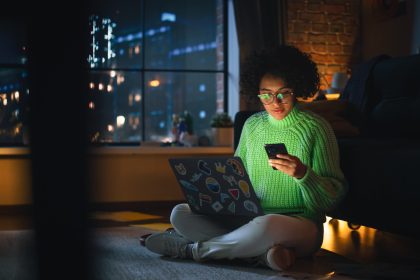Simple adjustments can eliminate eye strain, reduce headaches, and protect your sight for years to come
The average American now spends over 11 hours daily staring at screens, with many professionals logging 13+ hours between work and personal device use. This unprecedented visual demand creates significant stress on eye structures never evolved for such intense, prolonged focus. While concerns about digital eye damage continue growing, practical strategies exist to maintain optical health without dramatically reducing screen time.
How screen time silently damages your vision
Digital devices create multiple unique challenges for the visual system that collectively contribute to both immediate discomfort and potential long-term damage. Understanding these specific mechanisms reveals why traditional vision care approaches prove insufficient for modern digital demands.
The most immediate impact involves severe reduction in blinking rate – from a normal 15-20 blinks per minute down to just 5-7 during screen use. This dramatic decrease leaves the eye surface inadequately lubricated, accelerating tear evaporation and creating friction with each eye movement.
Simultaneously, the natural focusing system faces extraordinary demand through constant near-focus engagement. The ciliary muscles that adjust lens shape for clear vision become locked in sustained contraction, creating tension patterns similar to holding a dumbbell permanently flexed. This visual “muscle cramp” triggers referred pain that manifests as headaches, neck tension, and generalized fatigue.
Beyond these immediate effects, concerns emerge regarding cumulative blue light exposure. The high-energy visible light spectrum emitted by digital screens penetrates to the retina’s deepest structures, potentially accelerating light-induced oxidative damage associated with age-related vision decline.
8 research-backed strategies that preserve eye health
Specific protective measures directly address these visual challenges while integrating seamlessly into digital-intensive lifestyles. These approaches focus on modifying viewing habits, optimizing environments, and strengthening ocular resilience without requiring dramatic lifestyle overhauls.
1. Master the essential 20-20-20 technique
The 20-20-20 method represents the single most effective intervention for preventing digital eye strain. This approach interrupts the focusing muscle lock that occurs during sustained screen work. The technique requires looking at something 20 feet away for 20 seconds every 20 minutes of screen time.
The effectiveness stems from how this specific distance and duration combination triggers complete ciliary muscle relaxation while remaining practical within work contexts. The 20-foot focal point forces complete disengagement of near-focusing tension, while the 20-second duration allows sufficient time for muscle relaxation without significantly disrupting workflow.
For implementation, position reference objects at appropriate distances within your regular field of view – perhaps through windows or down hallways. Set inconspicuous timers using specialized apps or simple smartphone reminders to ensure consistent practice during focused work periods.
This technique reduces eye strain symptoms by approximately 60% when properly implemented, with benefits noticeable within the first day of consistent practice. The simplicity and effectiveness make this the foundation of any comprehensive eye protection strategy.
2. Optimize screen position for natural eye alignment
Screen positioning significantly impacts ocular strain through its influence on both focusing demand and blinking patterns. Computer monitors should position with the screen center 15-20 degrees below eye level (approximately 4-5 inches) and 20-26 inches from your face.
This specific positioning aligns with natural downward gaze angle, allowing more corneal coverage by the eyelid during each blink while reducing surface area exposure to environmental air flow. The measurable effect includes a 30% improvement in tear film stability and corresponding reduction in dry eye symptoms.
Positioning distance matters equally, as screens placed too close create excessive focusing demand, while those too distant encourage harmful forward head posture. The ideal distance allows viewing the entire screen without head movement while maintaining a comfortable arm’s length position.
For multi-screen setups, arrange displays to minimize head turning by placing the primary screen directly centered and secondary screens within a 30-degree arc to either side. This configuration reduces both focusing transitions and neck strain during extended work sessions.
3. Implement strategic lighting adjustments
Environmental lighting significantly influences eye strain through its interaction with screen glare and contrast ratios. The optimal arrangement places ambient room lighting at approximately 50% of typical office levels, with task lighting directed at reference materials rather than screens.
This reduced ambient lighting minimizes the harsh contrast between screen brightness and surrounding environments that triggers pupil size fluctuations. These constant pupillary adjustments create additional muscle fatigue that compounds other strain factors during extended sessions.
For maximum benefit, position light sources to prevent direct reflection on screens while providing adequate illumination for peripheral tasks. Light positioned above and behind viewing positions typically creates ideal conditions, eliminating forward-facing glare that stimulates squinting behaviors.
Window positioning deserves particular attention, as natural light creates the highest potential contrast problems. Workstations should ideally position perpendicular to windows rather than directly facing or backing them. When this arrangement proves impossible, adjustable blinds or screen filters become essential compensatory tools.
4. Customize your device display settings
Default device settings rarely optimize for ocular health, instead prioritizing battery life or aesthetic appeal. Specific display adjustments can dramatically reduce eye strain while better protecting retinal structures from potential light damage.
Brightness settings should match the environmental light levels, neither appearing as a glowing light source in dark rooms nor fading into invisibility under bright conditions. A practical test involves looking at a white background – if it appears like a light source, brightness remains too high; if it appears gray, brightness needs increasing.
Color temperature adjustments prove equally important, with warmer settings (reduced blue light) preferred during evening hours. This spectrum shift not only reduces potential retinal exposure to high-energy wavelengths but also avoids disruption of circadian rhythms that regulate sleep patterns.
Text settings dramatically influence reading comfort, with black text on white backgrounds creating excessive contrast that stimulates pupillary fluctuation. Dark mode or sepia backgrounds reduce this contrast while maintaining readability. Font size should allow reading without leaning forward, typically requiring 50% larger text than might seem aesthetically preferable.
5. Harness the protective power of proper hydration
Systemic hydration status directly influences tear film quality and quantity, with even mild dehydration reducing tear production by 25-30%. This reduction accelerates evaporation rates while decreasing the protective nutrient content of tears that nourish the corneal surface.
For optimal ocular hydration, water consumption should reach approximately 0.5-0.7 ounces per pound of body weight daily (roughly 2-3 liters for average adults). This intake level ensures adequate tear production while supporting proper blood viscosity that influences nutrient delivery to ocular structures.
The consumption pattern matters significantly, with steady intake throughout the day proving more beneficial than large, infrequent quantities. Keep water within arm’s reach during screen sessions, with small sips every 20-30 minutes maintaining consistent hydration levels without requiring frequent bathroom breaks.
Dietary factors additionally influence tear quality, with omega-3 fatty acids particularly supporting the lipid layer that prevents evaporation. Regular consumption of cold-water fish, flaxseeds, or walnuts provides these essential fats that improve tear film stability during extended screen sessions.
6. Leverage visual ergonomics through font modifications
Typography choices significantly impact visual processing demand, with certain fonts requiring substantially less ocular effort than others. Sans-serif fonts like Arial, Verdana, or Calibri reduce visual processing complexity by approximately 20% compared to serif alternatives like Times New Roman.
The size-to-distance ratio represents another critical factor, with optimal text requiring a 3.5mm x-height (capital letter size) for every meter of viewing distance. This translates to approximately 12-point font at standard monitor distances, though individual visual acuity may necessitate adjustments.
Line spacing (leading) should reach at least 1.5 times the text height to reduce tracking errors during extended reading. This increased spacing prevents accidental line skipping while reducing the focusing precision required for sustained text processing.
For maximum benefit, customize document defaults in frequently used applications rather than adjusting each document individually. This systemic approach ensures consistent visual ergonomics across all digital interactions while eliminating the friction of repeated adjustments.
7. Introduce protective pauses through mindful blinking
Conscious blinking represents one of the most accessible yet overlooked interventions for digital eye protection. The technique involves periodically performing full, deliberate blinks that completely refresh the tear film rather than the partial blinks that commonly occur during screen focus.
The most effective approach includes 5-10 full blinks performed every 20 minutes, ideally combined with the 20-20-20 looking exercise. These complete blinks redistribute the tear film while expressing essential oils from meibomian glands that prevent evaporation between blinks.
For enhanced effectiveness, incorporate the “butterfly technique” – a gentle full closure held for two seconds before reopening. This brief closure allows complete tear redistribution while giving momentary rest to the muscles that maintain open eye positions during sustained screen viewing.
The measurable benefits include 40-60% improvement in tear film stability tests and corresponding reduction in end-of-day dryness symptoms. This simple practice essentially resets the ocular surface to morning conditions throughout the day rather than allowing progressive deterioration during extended sessions.
8. Strengthen ocular resilience through targeted nutrition
Specific nutrients directly support the structures most stressed by digital device use, with particular emphasis on those that enhance tear production, support focusing muscle endurance, and protect against oxidative light damage. These nutritional interventions build cumulative protection rather than merely relieving symptoms.
Lutein and zeaxanthin serve as natural blue light filters within the retina, absorbing potentially damaging high-energy wavelengths before they impact sensitive photoreceptors. Food sources including kale, spinach, and yellow peppers provide these protective carotenoids in highly bioavailable forms that accumulate within ocular tissues.
Vitamin A compounds support tear production through their influence on mucin-producing goblet cells within the conjunctiva. Orange vegetables, leafy greens, and egg yolks provide these essential nutrients that maintain tear film quality during extended screen sessions.
Astaxanthin, a powerful carotenoid found primarily in wild salmon and krill, demonstrates particular benefit for focusing muscle endurance. Its potent anti-inflammatory properties support ciliary muscle recovery while reducing accommodation fatigue during sustained near vision tasks.
The synergistic combination of these nutrients creates comprehensive protection against the multiple challenges posed by digital device use, with benefits typically becoming noticeable after 8-12 weeks of consistent intake through either dietary sources or targeted supplementation.
Beyond the basics: Advanced protection strategies
While the fundamental approaches provide substantial protection, additional interventions offer incremental benefits for those with particularly intensive screen demands or existing visual vulnerabilities. These advanced strategies target specific aspects of digital eye strain with precision interventions.
Computer glasses with customized specifications
Special-purpose eyewear designed specifically for computer use offers significant advantages over general-purpose prescriptions. These specialized lenses typically incorporate multiple protective elements including anti-reflective coatings, slight magnification, and selective blue light filtering.
The most effective designs feature customized intermediate prescriptions that precisely match individual working distances rather than standard distance corrections that require constant focusing adjustment. For those under 40, these lenses provide subtle focusing assistance without full reading power; for those over 40, they offer precisely calibrated intermediate correction that eliminates the constant up-down head movements required with traditional bifocals or progressives.
The measurable benefits include 30-45% reduction in focusing fatigue and associated headaches, particularly during workdays exceeding 6 screen hours. The investment typically returns value through improved productivity and extended comfortable working capacity.
Environmental modifications for optimized viewing
Beyond basic lighting adjustments, comprehensive environmental design can significantly reduce ocular stress. Workstation position relative to air vents deserves particular attention, as direct airflow accelerates tear evaporation by 35-50% regardless of ambient humidity.
Monitor arms that allow dynamic positioning adjustment throughout the day enable posture variation that reduces static muscle tension. This movement capacity allows subtle distance modifications that prevent the progressive forward lean commonly developing during extended focus periods.
Document holders positioned at equal height and distance to screens eliminate the frequent focal transitions between paper and display that trigger excessive focusing adjustments. This simple tool reduces focusing demand by approximately 20% during tasks requiring reference material consultation.
Software solutions that enforce visual breaks
Specialized applications can overcome the natural tendency to bypass break schedules during intense work periods. These programs temporarily lock screens at specified intervals, requiring momentary disengagement before continuing work.
The most effective options incorporate customizable settings that align with personal work patterns and visual needs. Brief, frequent interruptions generally provide greater benefit than longer, less frequent breaks, particularly for tasks requiring sustained concentration and focus.
For maximum compliance, select applications that offer gradual implementation options, beginning with gentle reminders before progressing to mandatory breaks. This graduated approach builds healthy habits without creating workflow disruption that might otherwise lead to program disablement.
Creating your personalized eye protection plan
Digital eye strain manifests differently across individuals, necessitating personalized protection strategies that address specific symptoms and usage patterns. This customized approach typically delivers superior results compared to generic recommendations.
Begin by documenting current symptoms and their relation to particular activities or devices. Smartphone use, for example, typically creates different strain patterns than desktop work due to smaller text, closer viewing distances, and different posture dynamics.
Next, implement the core protective measures while tracking symptom changes to identify which interventions provide greatest personal benefit. This monitoring process reveals individual response patterns that guide further optimization.
For persistent symptoms despite basic interventions, consider professional evaluation with an eye care provider familiar with digital vision syndrome. Subtle visual inefficiencies often become symptomatic only under the intensive demands of digital device use, potentially requiring specialized correction or treatment approaches.
With consistent application of these eye-preserving strategies, most individuals can maintain comfortable, sustainable digital device use without sacrificing ocular health or visual comfort. The minimal investment in preventive measures yields substantial returns through both immediate comfort improvement and long-term vision protection.












